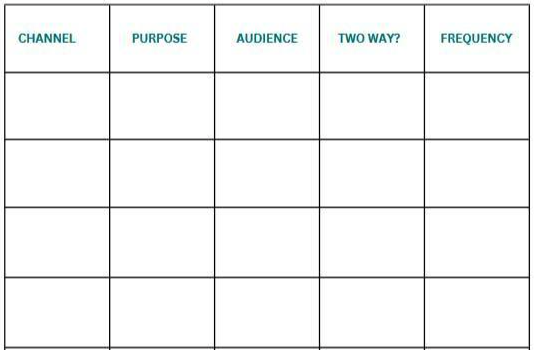Why effective communication channels are essential for business success
With so many ways to connect, it can be tough for organizations to know where to focus their communication efforts. That’s why we’re excited to have Joanna Parsons, CEO of The Curious Route, guest authoring this article. Joanna helps businesses optimize their internal communication, ensuring the right message reaches the right people. Here’s her take on why communication channels are the foundation of business success.
I hear from clients all the time about their struggles with reaching their employees. Companies are finding it challenging to get the right message to the right person at the right time.
Here’s the kind of things I’m hearing from clients:
- It was easier to reach everyone when we were all in the office together
- I have employees who work the machinery in our manufacturing plants, they don’t have email addresses and it’s so hard to reach them
- Some of our employees love email but the younger generation seem to want everything through instant message or their smartphone. How do we please them all??
These questions all point towards the same thing: your communication channels.
Now I love talking about communication channels, because even though they’re deeply unsexy and not very exciting, as a comms nerd I understand that they are ESSENTIAL. I like to think about communication channels as the foundations of your internal communication system. All your messages and campaigns will be built upon your channels, so if they’re not rock solid and fit for purpose then your entire system of communication is likely to fall down.
I also like to think about communication channels as infrastructure. If you think about physical infrastructure like railways or roads, we understand that these have been purpose-built to enable trains and cars to move around easily and deliver people from place A to place B. Similarly, your communication channels should be purpose-built to enable messages and ideas to move around your organization easily. They are your internal messaging infrastructure.
So let me repeat: your communication channels are essential.
It’s not enough to send email blasts to all employees. You must get intentional and thoughtful and strategic about building the foundations of your internal communications system so that you can reach the right employees with the right messages.
What kind of channels can I use to communicate with employees?
I remember an older colleague recounting a tale about working in an office before the internet was invented. There was no email, no intranet, no instant messaging, no video calls. Everything was either face-to-face or printed on paper. Their key communication channels were meetings and memos (which she said were also called ‘circulars’, there’s a phrase we rarely hear anymore). And she remembers that communication was largely one-way. There were limited opportunities to ask questions of leaders and there was certainly no such thing as an “Ask Me Anything” session with the CEO.
But the world of work has changed, and it has changed dramatically. The digital revolution has completely changed how we can communicate with our employees. The introduction of emails and intranets totally disrupted the usual modes of communication inside organizations. Digital technologies enabled information to move more quickly and more easily between colleagues than ever before.
And not only that, social media platforms and instant messaging technologies also disrupted how we communicate at work. Suddenly we could communicate more easily with anyone in the organisation, in a less formal way. We also had the means to share our own thoughts and opinions by commenting on blog posts or creating a post in an internal social feed.
All of this really changed how we think about communication channels. We don’t need to rely on overworked middle managers to cascade all of our messages anymore because we can reach people directly. And we don’t need to tell all employees about EVERYTHING that’s happening in the organization, we can create targeted and relevant communications for different internal audiences.
Here’s some of the channels you can use today to communicate with your employees:
- Emails
- Posters
- Intranet
- Video calls
- Digital screens
- Offsite retreats
- Employee apps
- Instant messages
- Digital newsletter
- Town hall meetings
- Desktop screensavers
There are so many channels to choose from these days. We are so lucky to be spoiled for choice, we can banish the paper circulars to memory and use smart technologies to build the infrastructure we need inside our organizations.
How do we know which channels are right for us?
Now, here’s the flip side of having so much choice: it makes it hard to figure out which channels we should pick to communicate. Which ones are the best? Which ones do we need?
I’m a firm believer that everything in internal communication is contextual and situational. So there’s really no such thing as a ‘best’ channel for all companies. There is only what is best for you, your employees and your business needs. You need to understand the business priorities and understand your employees to make an informed decision.
Understand your audiences
The MOST important thing to do when picking your channels is to invest time and energy into understanding your employee audiences. You simply cannot build your channels without a solid understanding of who they should target. Answer questions like:
- How do employees currently get information?
- What frustrations or complaints do they have about this current system?
- Where are our employees located? Are we all in one location or dispersed in different places?
- Are all of our employees sitting at desks with easy access to email during the day?
- Do all of our employees have company email addresses?
- How are we currently reaching frontline workers who don’t sit at desks?
- What kind of feedback do middle managers have about communication effectiveness?
- What are employees asking for that they’re not getting from our team?
Carving out the space to think about these questions first (before you choose your channels) will really help you take an audience-centric approach.
Understand your current channels
If you’ve never really thought about your communication channels as essential infrastructure before and you’re now thinking “hang on… I need to look at my channels to see if they’re any good”, then you can ask yourself questions like this to get started:
– What channels are we using to communicate right now?
– What is each channel used for?
– Are there employee groups that our channels aren’t able to reach?
– Do we have channels that are two-way and allow employees to engage with the content?
These questions will help set you up to review and evaluate your channels and think about any changes you need to make.
There’s a very simple tool that communication consultants love to use called a Communications Channels Matrix. This is a complicated name for a simple tool, it’s pretty much just a table you can use to map out your channels. It looks like this:

Here’s a step-by-step approach to how to use this table:
Step 1: List out your channels
In the first column, “channels”, list all the communication channels you currently use in your organisation. Complete the column from top to bottom with every channel you can think of. This should include any channel that’s currently used for sharing information with employees, listening to employees or reaching employees.
Step 2:
After you’ve listed out as many channels as you can think of, the next step is to think about what they’re used for. Do you know the purpose of each channel you’ve listed in column 1?
Say, for example, you’ve listed “CEO town hall meeting” as one of your channels. You might write that the purpose of this channel is “To provide high-level updates on the company’s progress towards our strategic goals and financial targets.” So for each channel you have, make an effort to capture the purpose of it so you understand why it’s in place.
Step 3:
Now you’re going to map each channel to an audience. Who is the intended audience for each channel you’ve listed in this table? For example, maybe one of your channels is a Leadership Forum and the audience for this is Senior Managers and above. Or maybe you have an employee app that is specifically intended for frontline workers who don’t have access to email. Think through each of your channels and plot out the audience for each.
Step 4:
In this step you’re going to assess whether each channel in your list is for one-way communication or for two-way communication. One-way means a communication is being broadcast out to employees but they can’t interact with it or engage with it, for example an email from a “do not reply” email address or a blog with the comments turned off.
Two-way channels, on the other hand, allow employees to reply, engage or interact with the content, for example blogs that you can comment under or forums where you can join a discussion or an email newsletter where you can hit reply. So for each channel you have, write down either “one-way” or “two-way” in this column.
Step 5:
And the final step in completing this table is to assess the frequency of each channel. How often is each channel used? For example, if you have a CEO town hall meeting maybe this happens once a quarter and maybe you have an intranet blog that is updated twice a week. Try to write down how often each channel is used to communicate.
Now do your review
And now comes the fun part (if you’re a comms nerd like me) – it’s time to review the table you’ve just painstakingly completed. Try to look at it with a critical eye. And ask yourself these questions:
- What gaps or challenges can I see?
- What opportunities exist?
- What can I see in this table that I didn’t realise before?
- How many channels do we have? Is this too many or too few?
For example, you might notice that all of your channels are one-way only and you’re not creating opportunities to listen to your employees. Or you might notice that all of your channels are targeted at “all employees” in the audience column, which suggests that there’s no targeted communications going on.
You might realise during this process that you need to make some changes to the channels you are using to communicate with employees. You might realise that you need to invest in some new tech because you’re unable to effectively reach your frontline workers who don’t have access to email. Or you might decide to get rid of a few channels that don’t really have a clear purpose and aren’t adding any value.
The decisions you make about the channels you use should be based on (a) the needs of the business, (b) the ability to reach employees where they are and (c) a consumer-grade approach to make employees actually enjoy the communication experience at work.
The bottom line
So the key takeaway is this: you should choose your communication channels carefully. They are the foundation for your entire system of internal communication and will act as the infrastructure to help your messages move around the organisation.
Want to know more? Subscribe to my newsletter.
Want to know more about how Appspace can help with internal communications? Try Appspace employee comms for yourself.



